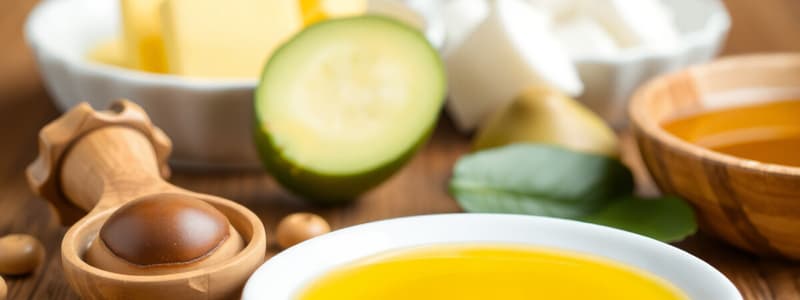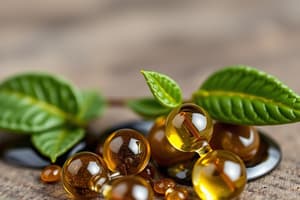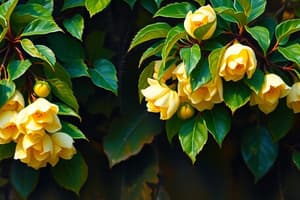Podcast
Questions and Answers
What distinguishes plant oils from fats in terms of their physical state at room temperature?
What distinguishes plant oils from fats in terms of their physical state at room temperature?
- Oils are liquid, fats are solid. (correct)
- Both oils and fats are solid.
- Both oils and fats are liquid.
- Oils are solid, fats are liquid.
Which of the following types of fatty acid chains is characterized by having no double bonds?
Which of the following types of fatty acid chains is characterized by having no double bonds?
- Polyunsaturated fats
- Trans fats
- Monounsaturated fats
- Saturated fats (correct)
What process is used to saturate an unsaturated fatty acid chain, allowing it to last longer?
What process is used to saturate an unsaturated fatty acid chain, allowing it to last longer?
- Fermentation
- Hydrogenation (correct)
- Esterification
- Emulsification
Which type of oil is known as a 'drying oil' and is often used in paints and varnishes?
Which type of oil is known as a 'drying oil' and is often used in paints and varnishes?
What is the effect of trans fatty acids on cholesterol levels in the human body?
What is the effect of trans fatty acids on cholesterol levels in the human body?
What is a characteristic of cis double bonds in a fatty acid chain?
What is a characteristic of cis double bonds in a fatty acid chain?
Which of the following oils is commonly used in processed foods and cosmetics?
Which of the following oils is commonly used in processed foods and cosmetics?
What happens to oils when hydrogenation is performed?
What happens to oils when hydrogenation is performed?
What is the primary fat type found in olive oil?
What is the primary fat type found in olive oil?
Which process is used to make unripe olives edible?
Which process is used to make unripe olives edible?
What distinguishes 'extra virgin' olive oil from regular virgin olive oil?
What distinguishes 'extra virgin' olive oil from regular virgin olive oil?
Which region is NOT traditionally known for olive cultivation?
Which region is NOT traditionally known for olive cultivation?
Which component of peanuts contributes to their classification as a legume?
Which component of peanuts contributes to their classification as a legume?
What is a common use for sesame oil in culinary traditions?
What is a common use for sesame oil in culinary traditions?
What process creates refined cottonseed oil suitable for consumption?
What process creates refined cottonseed oil suitable for consumption?
Which of the following oils contains the highest percentage of linoleic acid?
Which of the following oils contains the highest percentage of linoleic acid?
What unique aspect of sesame seeds contributes to their storage potential?
What unique aspect of sesame seeds contributes to their storage potential?
What is a popular legume-based product derived from peanuts?
What is a popular legume-based product derived from peanuts?
Which oil is considered less suitable for high-temperature cooking due to its tendency to solidify?
Which oil is considered less suitable for high-temperature cooking due to its tendency to solidify?
What is the primary use of corn in the United States?
What is the primary use of corn in the United States?
What type of oil is extracted from safflower seeds?
What type of oil is extracted from safflower seeds?
What is the primary health benefit associated with omega-3 fatty acids?
What is the primary health benefit associated with omega-3 fatty acids?
What process is used to create soap from plant oils?
What process is used to create soap from plant oils?
Which component of soap is responsible for dissolving non-polar substances like grease?
Which component of soap is responsible for dissolving non-polar substances like grease?
Which historical civilization is noted for the earliest records of soap making?
Which historical civilization is noted for the earliest records of soap making?
Which plant is considered a significant commercial crop for oil production in Canada and Europe?
Which plant is considered a significant commercial crop for oil production in Canada and Europe?
What is a disadvantage of using biodiesel fuel compared to petroleum-based diesel?
What is a disadvantage of using biodiesel fuel compared to petroleum-based diesel?
Which oil is commonly used for making mild soap?
Which oil is commonly used for making mild soap?
What ancient document mentions soap-like substances used for cleansing?
What ancient document mentions soap-like substances used for cleansing?
What type of oil is primarily used for hair pomade historically by Ancient Romans?
What type of oil is primarily used for hair pomade historically by Ancient Romans?
Which of the following oils contains the highest amount of polyunsaturated fatty acids?
Which of the following oils contains the highest amount of polyunsaturated fatty acids?
What agricultural crop is known to be drought-tolerant and native to North America?
What agricultural crop is known to be drought-tolerant and native to North America?
What is the primary use of hot-pressed linseed oil?
What is the primary use of hot-pressed linseed oil?
Flashcards
Plant Oils
Plant Oils
Lipid-soluble triglycerides consisting of three fatty acids and glycerol, typically extracted from seeds or fruits.
Saturated Fats
Saturated Fats
Fats with no double bonds between carbon atoms, fully saturated with hydrogen atoms.
Unsaturated Fats
Unsaturated Fats
Fats with one or more double bonds in their fatty acid chains, not fully saturated with hydrogen.
Monounsaturated Oils
Monounsaturated Oils
Signup and view all the flashcards
Polyunsaturated Oils
Polyunsaturated Oils
Signup and view all the flashcards
Hydrogenation
Hydrogenation
Signup and view all the flashcards
Cis Double Bond
Cis Double Bond
Signup and view all the flashcards
Trans Double Bond
Trans Double Bond
Signup and view all the flashcards
Trans Fats
Trans Fats
Signup and view all the flashcards
Edible Oils
Edible Oils
Signup and view all the flashcards
Unsaturated plant oils
Unsaturated plant oils
Signup and view all the flashcards
Soap production
Soap production
Signup and view all the flashcards
Soap properties
Soap properties
Signup and view all the flashcards
Biodiesel fuel
Biodiesel fuel
Signup and view all the flashcards
Biodiesel and emissions
Biodiesel and emissions
Signup and view all the flashcards
Canola
Canola
Signup and view all the flashcards
Sunflower
Sunflower
Signup and view all the flashcards
Flax (Linseed)
Flax (Linseed)
Signup and view all the flashcards
Olive
Olive
Signup and view all the flashcards
Olive oil extraction
Olive oil extraction
Signup and view all the flashcards
Olive varieties
Olive varieties
Signup and view all the flashcards
Olive processing
Olive processing
Signup and view all the flashcards
Virgin olive oil
Virgin olive oil
Signup and view all the flashcards
Sesame seeds
Sesame seeds
Signup and view all the flashcards
Peanut origin
Peanut origin
Signup and view all the flashcards
Cottonseed oil source
Cottonseed oil source
Signup and view all the flashcards
Corn or Maize use
Corn or Maize use
Signup and view all the flashcards
Soybean origin
Soybean origin
Signup and view all the flashcards
Safflower's original use
Safflower's original use
Signup and view all the flashcards
Study Notes
Plant Oils: Fats, Soaps, and Waxes
- Plant oils are lipid-soluble triglycerides composed of three fatty acids and glycerol.
- Oils are liquid at room temperature, while fats are solid.
- Oils are typically extracted from seeds or, less frequently, from fruits.
- Edible oils include olive, soybean, sunflower, and safflower.
- Coconut and palm oils are commonly used in processed foods and cosmetics.
- "Drying oils" (e.g., cottonseed, linseed) are highly unsaturated and used in paints, varnishes, and lubricants.
- Plant oils are used increasingly to produce biodiesel fuel.
Types of Fats
- Saturated fats: No double bonds between carbon atoms in the fatty acid chain; fully saturated with hydrogen.
- Unsaturated fats: One or more double bonds in the fatty acid chain; not saturated with hydrogen.
- Monounsaturated: One double bond.
- Polyunsaturated: Multiple double bonds. (Omega-3 and Omega-6 are important examples).
- Hydrogenation: Adding hydrogen to an unsaturated fatty acid to create a saturated fatty acid; increases stability and melting point but produces trans fats.
- Cis double bonds: Hydrogen atoms are on the same side of the double bond; creates a bent structure.
- Trans double bonds: Hydrogen atoms are on opposite sides of the double bond; creates a linear structure; more stable and often higher melting point. Trans fats are not naturally found in plant oils.
Soap
- Soap is a salt of a fatty acid, formed when a fatty acid reacts with a strong base (saponification).
- Plant or animal oils are used to produce soap.
- The triglycerides are broken down into salts and glycerol.
- Soap molecules have a hydrophobic fatty acid end and a hydrophilic salt end, enabling them to emulsify and remove grease and dirt.
- Historically, soaps were made by hydrolyzing oils with lye, separating glycerol from the crude soap.
- Early soap-making records date to around 4,000 years ago in Babylon.
- Commercial soaps and shampoos often use detergents, such as sodium laureth sulfate (SLES) and sodium lauryl sulfate (SLS).
Biodiesel Fuel
- Biodiesel fuel is made from methyl esters, produced by transesterification using alcohol (typically ethanol or methanol) to replace glycerol in the fatty acid chain.
- Biodiesel has lower lifecycle emissions than petroleum-based diesel.
- Biodiesel's energy balance can vary based on the plant source.
- Plants like palm oil and algae have high production efficiency.
- Biodiesel may have higher nitric oxide emissions.
Major Plant Oils (Cool Temperate Climates)
- Canola (Brassica napus): A versatile crop (canola oil, rutabaga, kale); high in healthy oils (omega-3 and -6); rich in polyunsaturated fatty acids.
- Sunflower (Helianthus annuus): Drought-tolerant, originating from North America; now developed with high oil content.
- Linseed/Flax (Linum usitatissimum): High in omega-3 and -6 fatty acids, vitamin E, and protein; used for edible and industrial oils.
- Olive (Olea europaea): Native to the Mediterranean, long-lived, high quality oils extracted from the fruit. Virgin olive oil is cold-pressed. High in monounsaturated fats like oleic acid.
- Sesame (Sesamum indicum): Ancient cultigen, high in unsaturated fats, protein, iron, and calcium; used in Middle Eastern and Asian cooking.
- Peanut (Arachis hypogaea): Cultivated in South America for millennia; high in unsaturated oils, protein, and vitamins; used in cooking and processed foods.
- Cottonseed (Gossypium hirsutum): By-product of the cotton industry; refined oil used in foods; high in vitamin E.
- Corn/Maize (Zea mays): Large annual grass from Central America; high polyunsaturated oil (linoleic acid).
- Soybean (Glycine max): Originated in East Asia; high in protein and edible oils; widely used in Asian cuisine.
- Safflower (Carthamus tinctorius): Initially used for dye; now a major oil crop, high in linoleic acid.
Studying That Suits You
Use AI to generate personalized quizzes and flashcards to suit your learning preferences.




